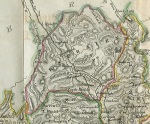The Parish of Carsphairn.
Placenames
The placenames index for this parish is accessed via the menu on the left. Links from there open up access to various historical and modern maps indicating where the place is to be found as well as links to other historical information and photographs if we have them.
References
Extensive historical information, particularly in the form of scanned books, is becoming available on the Internet.
In this section we have begun listing links to this information relative to this parish.
Old Postcards
Thanks to a Victorian hobby of collection topographical postcards many old views from within the parish are available today. This section contains an ever growing
selection from those we have available.
A TOPOGRAPHICAL DICTIONARY OF SCOTLAND, by Samuel Lewis. Published in 2 vols, London, 1846.
"CARSPHAIRN, a parish, in the stewartry of Kirkcudbright, 12 miles (N. W. by N.) from New Galloway ; containing 790 inhabitants, of whom 103 are in the village. This place, which was separated from the parishes of Kells and Dairy in 1627, is supposed to have derived its name from the erection of the church and village on a small level plain, at that time overgrown with fern. The parish is bounded on the east by the river Ken, and on the north and west by Loch Doon and the county of Ayr ; it is nearly circular in form, about ten miles in length, and nearly nine in breadth, comprising about 56,000 acres. The surface, with the exception of a small tract of arable land around the village, is mountainous and hilly. The highest of the mountains is Cairnsmuir, which has an elevation of 2696 feet above the sea, commanding an unbounded view in every direction, except the south-west, where it is obstructed by the mountain of Carlines Cairn, nearly equal in height. The lower hills are covered with heath ; but those of greater elevation are well clothed with verdure to their summits, affording excellent pasturage for sheep and black cattle. The river Deugh, which descends from the northern heights, with great rapidity, takes a south-easterly course, and flows into the Ken ; and the parish is also intersected by numerous mountain streams, some of which abound with trout. The scenery is, for the most part, wild, with scarcely any ancient wood, and but very small patches of modern
plantations.
The lands are principally occupied as sheep-walks, which have been improved by surface draining, and the parish is almost entirely pastoral ; about 30,000 sheep, of the black-faced breed, are regularly pastured, and a very considerable number of cattle, of the Highland breed, are kept during the winter, and, in summer, sent to the English markets. The rateable annual value of the parish is £5414. The substrata are chiefly greywacke and granite ; iron and lead ore are found, and it is said that the former was wrought for many years, till the woods producing charcoal were exhausted. A rich vein of lead-ore has been discovered, on the lands of the Honourable Col. Cathcart, who has spared no expense in bringing it into successful operation, for which purpose he has employed a large number of miners, chiefly from Wanlockhead and Leadhills. Buildings have been erected for crushing, washing, and smelting the ore, on the most approved plans, and for separating the silver from the lead, under the superintendence of skilful overseers. Cottages for the workmen have been built on the spot, and a schoolmaster's house, and spacious schoolroom for the instruction of their children ; and the proprietor gives a liberal salary to the master and mistress.
The village is small; a post-office, a branch of that of Ayr, has been established, and facility of communication is afforded by the turnpike-road from Dumfries to Ayr. The ecclesiastical affairs are under the superintendence of the presbytery of Kirkcudbright and synod of Galloway. The minister's stipend is £182. 10., with a manse, and a glebe valued at £27 per annum ; patrons, the Crown and the Forbes family. The church, which is nearly in the centre of the parish, is a plain structure, erected within the last twenty years, and containing sufficient sittings. The parochial school is well conducted ; the master has a salary of £34, with a house and garden, also the interest of £500, bequeathed by the late Mr. Mc Adam, and the fees average about £15. The poor have the proceeds of various bequests amounting to £800, of which £500 were left by Mr. Mc Adam. The chief remains of antiquity are cairns, in some of which, on their removal, stones, in the form of coffins, were found, containing human bones ; there are also remains of a Druidical circle. The late Dr. Jackson, professor of natural philosophy in the university of St. Andrew's, was a native of the place. "
